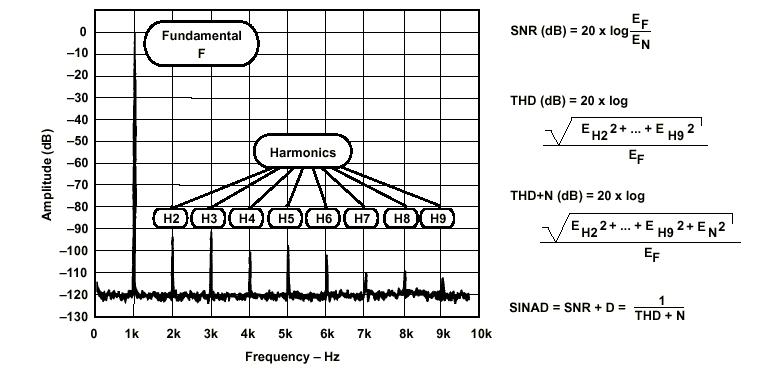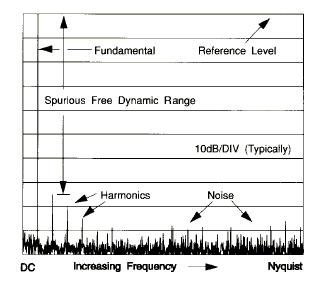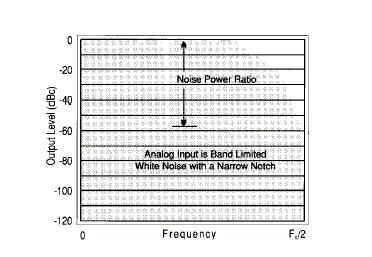ADC/DAC performance __"ABC soup "
|
ADC
=
A nalog to Digital Converter
|
DAC =
D igital to Analog Converter
(A2D: Analog to Digital) (D2A: Digital to Analog) DC = quasi-static parameters | AC = dynamic parameters (DC : "direct - current") (AC: "alternating - current") |
Standards:
Basic parameters:IEEE IM TC-10 Technical Committee on Waveform Measurement and Analysis
http://grouper.ieee.org/groups/1057
IEEE 1057 - Standard for Digitizing Waveform Recorders
This working group is currently updating Std. 1057- 1994. The goal is to update the standard to make it consistent with the analog to digital converter standard and to make it more user frien dly.
IEEE 1241 - Standard for Terminology and Test Methods for Analog-to-Digital Converters
This working group completed IEEE standard 1241 in late 2000. The group is currently working towards incorporating much of this standard into an IEC standard on dynamic testing of ADCs.
IEEE 1658 - Standard for Terminology and Test Methods for Digital-to-AnalogConverters
In preparation. This working group was officially started in the Spring of 2004 . The group is currently working towards writing a standard on the static and dynamic testing of DACs .

Methods and draft standards for the DYNamic characterization and testing of
Analogue to Digital Converters. European Project DYNAD
http://www.fe.up.pt/~hsm/dynad/index.htmlIMEKO TC-4 Working Group on
Analogue-to-Digital & Digital-to-Analogue Converter Metrology
http://lesim1.ing.unisannio.it/tc4/ADCAndDACMetrology.htm
EUPAS: EUropean Project for ADC-based devices Standardization,
IMEKO TC-4 Working Group on A/D Converters
http://elve.le.ttu.ee/mesel_www_home/R&D/ADC/EUPAS.HTM
IEC 62008 Ed. 1.0 b: 2005
Performance characteristics and calibration methods for digital data acquisition systems and relevant software
http://domino.iec.ch/preview/info_iec62008%7Bed1.0%7Db.pdf
S. W. Smith : " The Scientist & Engineer's Guide to DSP "
Ch. 2 - Statistics, Probability and Noise | Ch. 3 - ADC and DAC
Understanding Data Converter | Data Converter Terminology
ADC and DAC Glossary
~~~
"[What's important to note is that] while differential non-linearity is found in all DACs as well as ADCs, it has no counterpart in the analog domain. Differential non-linearity, like jitter, is a uniquely digital form of non-linear distortion" [D. Rife]
"It is also known that of the [above-mentioned] ADC test techniques only histogram analysis can give localized information about converter's errors (e.g., non-linearity parameters like differential (DNL) and integral non-linearities (INL)). The effect of an error on a particular bit of the ADC is dissolved within the RMS error in the sine wave fitting, or into the noise power of the discrete Fourier transform ." [Mendonça et al: ADC testing using joint time-frequency analysis, Computer Standards & Inerfaces, Vol.23, May 2001, pp 129-135]
DC performance ___"transfer
function (linearity); intrinsic parameters"
- OE: offset error
- GE: gain error
- DNL: Differential Non-Linearity (DLE: Differential Linearity error)
- monotonicity (DAC ), NMC: non missing code (ADC)
- INL: Integral Non-Linearity (ILE: Integral Linearity Error)
- equivalent RMS input noise
- PSRR: Power Supply Rejection Ratio
"The Relationship between Harmonic Distortion and Integral Non-Linearity "
INLandSFDR
ADC definitions and specifications
The ABCs of ADCs : Understanding How ADC Errors Affect System Performance
The Wild West of Data Acquisition Performance Specifications
AC performance ___ "noise and distortions; transmission parameters"
- SNR: Signal-to-Noise Ratio (without harmonics)
-
SNHR: signal to non-harmonic ratio |
SRNR: signal to random noise ratio
- THD: Total Harmonic Distortion
-
SDR
: signal-to-distortion-ratio

NOTE: Amplifiers and Bits: An Introduction to Selecting
Amplifiers for Data Converters,
- SINAD: SIgnal to Noise And Distortion ratio
-
SNDR : signal-to-noise-and-distortion ratio
- SFDR: Spurious-Free Dynamic Range
SNR / THD / SINAD Calculator , pdf | Data conversion calc2 / calc3
-
UCFDR: unwanted-component-free dynamic range | SFSR:
spurious-free signal range
- ENOB: Effective Number Of Bits


-
NOEB: number of effective bits
- IMD: InterModulation Distortion
EB: effective (equivalent) bits
Understanding ENOB
-
twotone IMD
multitone IMD
- NPR: Noise Power Ratio
- MTPR: MultiTone Power Ratio
- ERBW: Effective Resolution BandWidth
- FPBW: Full-Power BandWidth
- SSBW: Small Signal BandWidth
"The Relationship between Harmonic Distortion and Integral Non-Linearity "
INLandSFDR | SQNR vs. SFDR
Defining and Testing Dynamic Parameters in High-Speed ADCs
Analog Acquisition Sub-System Testing in the Frequency Domain
Understanding data converter frequency domain specifications
Understanding high speed ADC testing and evaluation
Understanding and comparing datasheest for high-speed ADCs
A reproducibile procedure for ADC testing
ADC_Jitter | FoM
| Analog Devices
· Live data sheets! ADC Analyzer™ incorporates ADIsimADC™ in conjunction with product model files. Using ADIsimADC both streamlines and improves system design evaluation. It enables the designer to observe detailed performance data for a 'simulated' ADC design within minutes. Product model files are used in conjunction with the simulator engine to produce datasheet-like ADC performance results given a specified operating condition. Data output can be extracted for further analysis. ADIsimADC WEB based version: http://designtools.analog.com/dtSimADCWeb/dtSimADCMain.aspx * National offers for sale demonstration kits which includes fully loaded and tested evaluation board that is ready to help you evaluate the performance of the various A/D Converters. Many of these converters can be evaluated with the aid of our WaveVision® software , which is supplied with the evaluation board. To evalute many of these ADCs with the WaveVision® software, it is necessary to connect the evaluation board to our Digital Interface Board. ADC Channel Design process: Signal-Path Designer Webench * * * |
Design-to-test (D2T
) and design-for-test (D4T) of mixed-signal
devices:
![]() HABIST case
study
HABIST case
study
EDN Hands-On Project:
Demystifying ADCs
·
Remystifying ADC
"Before getting into our test results, it might be useful
to define the following terms.
Conversely, high SFDR is of prime importance in communications applications. Digital wireless systems can falsely recognize spurs as channels. The way to obtain high SFDR at the expense of SNR is to restrict the full-scale input range. Designers of data-acquisition and automatic test systems are principally interested in THD, because it's a measure of the integral linearity of the transfer function. High SINAD is important in medical systems and automatic test equipment." |
******
Selecting The
Optimal DAC
Means Knowing
How To Interpret Converter Specifications
And Their Effect On System Performance
| Intersil ·
Test Drive our CommLink™
DACs! DAC Test Drive · We Test - You Drive! Simply fill out a on-line form to request your customized test for Intersil's CommLink TM family of DACs. |
Practical
Telecom DAC Testing
Selecting mixed-signal components -
aliases, images, and spurs
| "Several specifications
can be used to measure the dynamic performance
of D/A converters in the frequency domain (see Figure 4):
Spurious-free dynamic range (SFDR)—the difference in signal strength (dB) between the desired signal (could be single tone or multi-tone) and the highest spurious signal in the band being measured (Figure 4). Often, the strongest spurious response is one of the harmonics of the desired output signal. In some applications, the SFDR may be specified over a very narrow range that does not include any harmonics. For narrowband transmitters, where the DAC is processing a signal that looks similar to a single strong tone, SFDR is often the primary spec of interest.These specifications, or others derived from them, represent the primary measures of a DAC’s performance in signal-synthesis applications. Besides these, there are a number of conventional DAC specifications, many associated with video DACs or other applications, that are still prevalent on DAC data sheets. These include integral nonlinearity (INL ), differential nonlinearity ( DNL ), glitch energy (more accurately, glitch impulse), settling time , differential gain ( DG ) and differential phase (DP ). While there may be some correlation between these time-domain specifications and the true dynamic measures, the time-domain specs aren’t as good at predicting dynamic performance." |
![]() Fundamentals
of modern audio
measurements
Fundamentals
of modern audio
measurements
HpW-Works
Read the fine print
or suffer the consequences |
How to read
a semiconductor data sheet
~~~~~
Result of search for 'ADC' and 'DAC
' among acronyms
| http://www.acronymfinder.com/ | |
|
... ADC Airborne Digital Computer ADC Aircraft Directive Configuration ADC Alzheimer's Disease Center ADC American-Arab Anti-Discrimination Committee ADC Analog Detection Circuit ADC Analog-to-Digital Converter ADC Analysis Date Concentrator ADC Animal Damage Control program ADC Anodal Duration Contraction ... |
DAC Digital-to-Analog Converter DAC Data Access Component DAC Data Acquisition DAC Data Acquisition & Control DAC Data Acquisition Converter DAC Data Analysis Console DAC Data Authentication Code DAC Days After Contract (award) DAC Defense Acquisition Circular ... |
